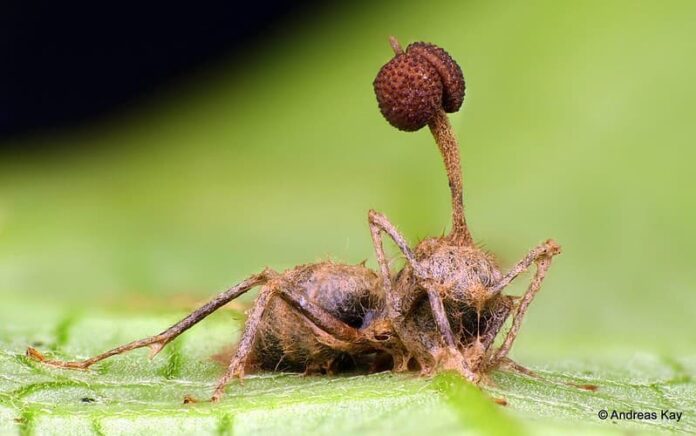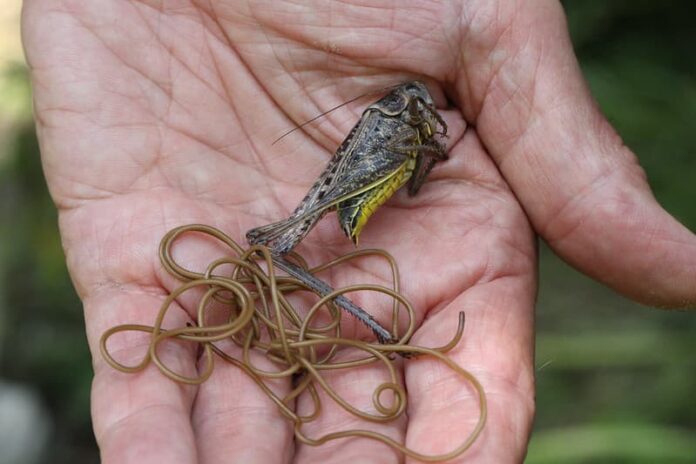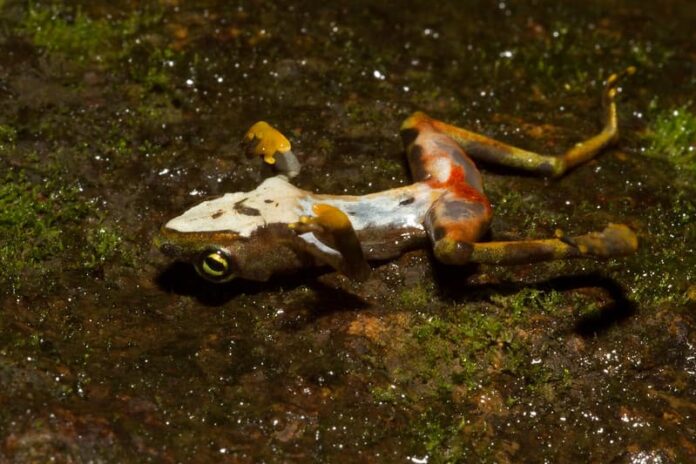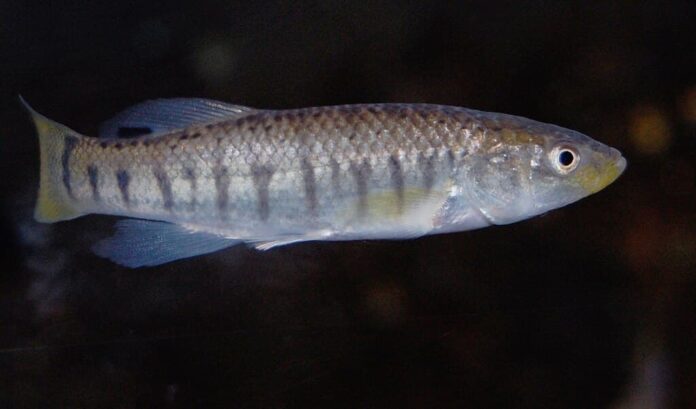Animal zombies are not something new, research and studies have shown multiple cases of them already. Since 2021 is just another bad year and people said there could be a zombie apocalypse next year, we can discuss animal zombies for now. This strange thing begins when particular parasites camp inside the animal hosts that they choose. The rest of the process will be explained below, so let’s take a look at the animal victims below.
1Carpenter Ant

Ophiocordyceps unilateralis is a fungus that lives in carpenter ants whose habitat is in tropical forests like Brazil and Thailand. After the fungus spore infects an ant’s exoskeleton, the zombification process begins. The fungus will obtain nutrients from the ant while growing a germtube and hyphae throughout the ant’s muscle network. As it grows, it slowly fills the ant’s body and head which causes the muscles to waste away. Three weeks later, the ant will be under the control of the fungus which leads to abnormal behaviors. The most common one is spending less time in the colony and wandering outside their own nests, becoming animal zombies. Then the fungus will command the ant to climb onto a plant at a height of about 25 centimeters above the ground.
According to the study, this height level provides the right humidity and temperature for the growth of the fungus. At the same time, this only occurs at high noon and the explanation for this remains unknown. When the ant reaches the height, the fungus releases a substance that destroys the ant’s jaw muscles. This results in “lockjaw”, the ant will tightly bite a leaf or twig without releasing. The fungus then uses a poison, and the ant host will die there. After the death of the ant, a long fungus stalk filling with spores emerges from the back of the ant’s head. When the fungus matures, its spores will spread to nearby soil and plants which infects the next victims.
2Caterpillar

If you think zombie scenes you see in horror movies are scary, you haven’t seen everything from mother nature yet. Baculovirus is a brainwashing virus that turns caterpillars into zombies to serve as its host. There are different types of baculovirus, and it affects almost all caterpillar species, especially gypsy moth caterpillars. It begins with a happy and innocent caterpillar who feeds on leaves just like normal caterpillars do. A healthy caterpillar feeds on leaves in the trees at night and then climbs back down in the morning to hide from predators. If it is unlucky, it eats the leaves with the spores of baculovirus which changes things completely.
This virus reprograms the caterpillar’s habits, making it stays on the treetops without coming back down. The infected caterpillar becomes sicker every day, and it stays up in the trees waiting for its doom. The scary part is that the virus uses the caterpillar’s body to make more viruses. At the same time, there are genes in the virus that make the caterpillar melt. In the end, the unfortunate caterpillar will turn into a house for millions of virus particles waiting to come out. When the time is right, those particles will drop onto the foliage below where they infect their brothers and sisters.
3Cricket

As for crickets, they are prone to be infected with a parasitic worm that grows inside their body. When the worm matures and needs to get out to mate, it takes control of the cricket’s brain. By driving the cricket’s mind, it leads the cricket to the body of water then jumps into the water and drowns. While the cricket is drowning, the worm then exits the host’s body through holes in the cricket’s exoskeleton. The terrifying part is that the worm is 10 times longer than the cricket itself so it is very painful to watch. Witnessing a giant worm coming out of a drowning cricket is not for the faint of hearts.
The parasitic worm is known as the horsehair worm or Gordian worm, and it requires an aquatic habitat to reproduce. This worm can produce mind-controlling chemicals that manipulate the mind of the poor jumpy creature, turning them into mindless zombies. Horsehair worm uses the cricket as an incubator for its larvae just before the mating season comes. The worm can produce large quantities of neurotransmitters inside the host, ordering it to jump into the water. Once it exits the cricket, it mates, lays eggs, and dies while the next generation waits to be eaten. Midges and mosquitos always come for the free meals, and so do the crickets and grasshoppers. And that is how the cycle of horror begins.
4Deer

It probably freaks you out a little if you watched a Korean zombie movie “Train To Busan” before. The infection began with a zombie deer, and it shakes the peace of mind a little knowing zombie deer exists. Chronic Wasting Disease is a fatal progressive neurodegenerative illness that infects the brain of deer, elk, and moose. The disease is spread by prions (neither bacteria nor viruses), the zombie-like pathogenic proteins that aren’t alive and can’t be killed. Prions trigger cells, particularly in the brain and spinal cord, to fold abnormally and start clumping. Once it infects, it eats away the brain which causes episodes of symptoms that resemble dementia. At the same time, the animals also experience hallucinations along with eating and walking difficulties, making them disoriented and wobbly. Those symptoms worsen over time before leading to death since there is no cure.
The interesting thing is that this disease is actually rare. However, it has been spreading in deer and other hoofed mammals throughout the United States, causing an outbreak. It is dangerous because it is an indestructible killer pathogen that could be lurking anywhere. People also called it Zombie Deer Disease because of the way the deer walks after the infection. It appears to be thin and weak while being unable to function normally. To clear the confusion, the infected deer do not attack other deer like zombies. But it can spread to other animals through direct or indirect contact with bodily fluids like blood, feces, saliva, and urine. There haven’t been any cases of chronic wasting disease in people so far, but scientists think it is possible. Since the disease can spread in macaques, mice, monkeys, and squirrels, only time can tell when it is the human’s turn.
5Japanese Tree Frog

A pathogenic fungus called Batrachochytrium dendrobatidis (Bd) is the cause of chytridiomycosis or Chytrid Fungus Disease. This disease kills amphibians by destroying their skin, disrupting their immune systems, and causing heart failure. The disease alone is responsible for many deaths which lead to the extinction of hundreds of frog species worldwide. At the same time, it also poses a threat to one-third of the world’s frogs, salamanders, and other amphibians. One frog species is the strongest among several others that can tolerate the pathogen, Japanese Tree Frogs. Despite preventing itself from calling, the pathogen can still cause effects on these amphibians.
While most animal zombies change their behaviors, these frogs change their mate calls. The infected males produce faster and longer calls which appear to be more attractive to the females. According to the study, Bd can act like a parasite and turn its male hosts into zombies. This unique call attracts more females due to the altered pitch that the males produce. Those male zombies attract and mate with more females, spreading Bd in the population. The females then pass on the disease to their offspring which later wipes out the population or entire species.
6Killifish

Zombies do not only walk on land but also swim in the water, and killifish is the species. There is this mind-sucking parasite that reproduces in seabird guts that can alter the behavior of the fish. This parasite is known as Euhaplorchis californiensis, and it spreads via bird droppings. Horn sea snails are one of the animals that eat the eggs of this parasitic worm from the droppings. After the eggs hatch, the larvae then asexually replicate inside the snail before breaking out and swimming freely in the water. Then the parasites latch on to a killifish and make their way inside the fish.
Once it gets inside the brain of the fish, things start to change in the killifish. The parasitic worms can limit the production of serotonin in the fish’s brain, taking control of the fish’s mind. At the same time, these worms make the fish swim near the water’s surface so that the birds could eat them. By often going to the surface so much, it won’t take long for the zombie host to become a bird’s lunch. The parasite then grows to maturity and reproduces inside the birds. Its eggs will be released into the marshes and ponds via the birds’ droppings, and the cycle starts again.
7Rodent

It is normal for mice and rats to run away from cats, but not for zombie rodents. A single-celled parasite Toxoplasma gondii infects the cells of mice and rats, creating unusual behaviors among them. After the infections, the fear leaves and the bravery comes in so they are no longer afraid of the cats. While having no fear of cats, these rodents are also attracted to the odor of cat urine. The better to say this is that they become sexually excited at the smell of cat urine. So these weird zombies will look for cats, turning itself into easy meals for the feisty feline. The infection then passes on to the cats, causing toxoplasmosis diseases which is common in cats.
It does not end there, the cats can also spread this disease to humans as well. The transmission is when the infected cats release the parasites into the environment through their feces. Upon contact or consume contaminated feces, the infection begins in birds, mammals, and humans. In humans, the disease infects body tissues such as the heart muscle and skeletal muscle as well as the brain and eyes. People with toxoplasmosis sometimes experience mental diseases such as anxiety syndrome, bipolar disorder, depression, and schizophrenia. In some cases, the immune system fights to kill or at least block the parasite. If the immune system is working well, the parasites might turn into a sleeping form without causing any damage.
Note: You have probably seen funny videos of mice fighting with cats. The difference is that the infected mice are fearless in terms of being around the cats. As for the mice who would fight with the cats, they are just the unique ones who are extra brave.
Related Post: Deadly Parasites You Should Know




